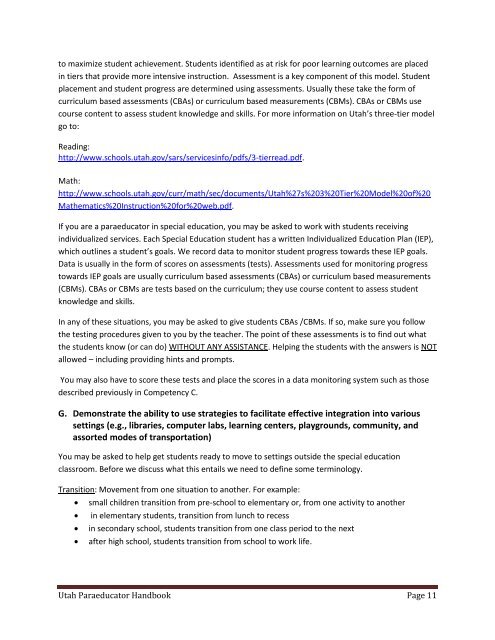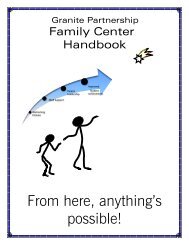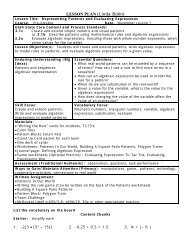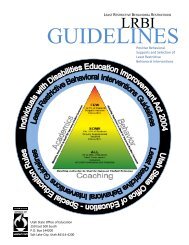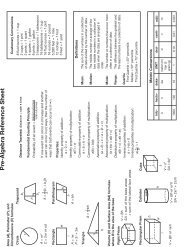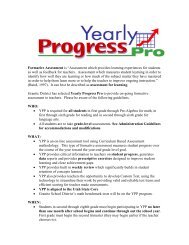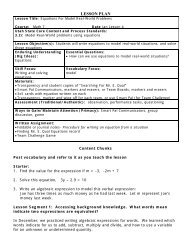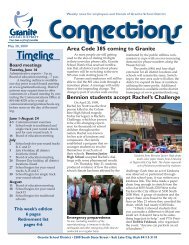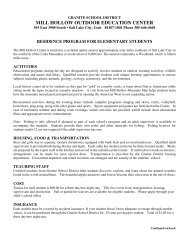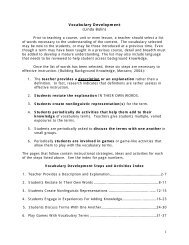Utah Special Education Paraeducator Handbook - Granite School ...
Utah Special Education Paraeducator Handbook - Granite School ...
Utah Special Education Paraeducator Handbook - Granite School ...
Create successful ePaper yourself
Turn your PDF publications into a flip-book with our unique Google optimized e-Paper software.
to maximize student achievement. Students identified as at risk for poor learning outcomes are placed<br />
in tiers that provide more intensive instruction. Assessment is a key component of this model. Student<br />
placement and student progress are determined using assessments. Usually these take the form of<br />
curriculum based assessments (CBAs) or curriculum based measurements (CBMs). CBAs or CBMs use<br />
course content to assess student knowledge and skills. For more information on <strong>Utah</strong>’s three-tier model<br />
go to:<br />
Reading:<br />
http://www.schools.utah.gov/sars/servicesinfo/pdfs/3-tierread.pdf.<br />
Math:<br />
http://www.schools.utah.gov/curr/math/sec/documents/<strong>Utah</strong>%27s%203%20Tier%20Model%20of%20<br />
Mathematics%20Instruction%20for%20web.pdf.<br />
If you are a paraeducator in special education, you may be asked to work with students receiving<br />
individualized services. Each <strong>Special</strong> <strong>Education</strong> student has a written Individualized <strong>Education</strong> Plan (IEP),<br />
which outlines a student’s goals. We record data to monitor student progress towards these IEP goals.<br />
Data is usually in the form of scores on assessments (tests). Assessments used for monitoring progress<br />
towards IEP goals are usually curriculum based assessments (CBAs) or curriculum based measurements<br />
(CBMs). CBAs or CBMs are tests based on the curriculum; they use course content to assess student<br />
knowledge and skills.<br />
In any of these situations, you may be asked to give students CBAs /CBMs. If so, make sure you follow<br />
the testing procedures given to you by the teacher. The point of these assessments is to find out what<br />
the students know (or can do) WITHOUT ANY ASSISTANCE. Helping the students with the answers is NOT<br />
allowed – including providing hints and prompts.<br />
You may also have to score these tests and place the scores in a data monitoring system such as those<br />
described previously in Competency C.<br />
G. Demonstrate the ability to use strategies to facilitate effective integration into various<br />
settings (e.g., libraries, computer labs, learning centers, playgrounds, community, and<br />
assorted modes of transportation)<br />
You may be asked to help get students ready to move to settings outside the special education<br />
classroom. Before we discuss what this entails we need to define some terminology.<br />
Transition: Movement from one situation to another. For example:<br />
<br />
<br />
<br />
<br />
small children transition from pre-school to elementary or, from one activity to another<br />
in elementary students, transition from lunch to recess<br />
in secondary school, students transition from one class period to the next<br />
after high school, students transition from school to work life.<br />
<strong>Utah</strong> <strong>Paraeducator</strong> <strong>Handbook</strong> Page 11


